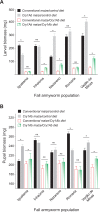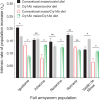Life-History Traits of Spodoptera frugiperda Populations Exposed to Low-Dose Bt Maize
- PMID: 27243977
- PMCID: PMC4887033
- DOI: 10.1371/journal.pone.0156608
Life-History Traits of Spodoptera frugiperda Populations Exposed to Low-Dose Bt Maize
Abstract
Exposure to Bacillus thuringiensis (Bt) toxins in low- and moderate-dose transgenic crops may induce sublethal effects and increase the rate of Bt resistance evolution, potentially compromising control efficacy against target pests. We tested this hypothesis using the fall armyworm Spodoptera frugiperda, a major polyphagous lepidopteran pest relatively tolerant to Bt notorious for evolving field-relevant resistance to single-gene Bt maize. Late-instar larvae were collected from Bt Cry1Ab and non-Bt maize fields in five locations in Brazil, and their offspring was compared for survival, development, and population growth in rearing environment without and with Cry1Ab throughout larval development. Larval survival on Cry1Ab maize leaves varied from 20 to 80% among the populations. Larvae reared on Cry1Ab maize had seven-day delay in development time in relation to control larvae, and such delay was shorter in offspring of armyworms from Cry1Ab maize. Population growth rates were 50-70% lower for insects continuously exposed to Cry1Ab maize relative to controls, showing the population-level effect of Cry1Ab, which varied among the populations and prior exposure to Cry1Ab maize in the field. In three out of five populations, armyworms derived from Bt maize reared on Cry1Ab maize showed higher larval weight, faster larval development and better reproductive performance than the armyworms derived from non-Bt maize, and one of these populations showed better performance on both Cry1Ab and control diets, indicating no fitness cost of the resistance trait. Altogether, these results indicate that offspring of armyworms that developed on field-grown, single-gene Bt Cry1Ab maize had reduced performance on Cry1Ab maize foliage in two populations studied, but in other three populations, these offspring had better overall performance on the Bt maize foliage than that of the armyworms from non-Bt maize fields, possibly because of Cry1Ab resistance alleles in these populations. Implications of these findings for resistance management of S. frugiperda in Bt crops are discussed.
Conflict of interest statement
Figures






Similar articles
-
Field-evolved resistance to Cry1Ab maize by Spodoptera frugiperda in Brazil.Pest Manag Sci. 2016 Sep;72(9):1727-36. doi: 10.1002/ps.4201. Epub 2016 Jan 4. Pest Manag Sci. 2016. PMID: 26617261
-
Cross-Resistance between Cry1 Proteins in Fall Armyworm (Spodoptera frugiperda) May Affect the Durability of Current Pyramided Bt Maize Hybrids in Brazil.PLoS One. 2015 Oct 16;10(10):e0140130. doi: 10.1371/journal.pone.0140130. eCollection 2015. PLoS One. 2015. PMID: 26473961 Free PMC article.
-
Fall armyworm (Lepidoptera: Noctuidae): practical resistance of 2 Brazilian populations to Cry1A.105 + Cry2Ab and Cry1F Bt maize.J Econ Entomol. 2024 Jun 10;117(3):1095-1105. doi: 10.1093/jee/toae082. J Econ Entomol. 2024. PMID: 38703104
-
Resistance of the fall armyworm, Spodoptera frugiperda, to transgenic Bacillus thuringiensis Cry1F corn in the Americas: lessons and implications for Bt corn IRM in China.Insect Sci. 2021 Jun;28(3):574-589. doi: 10.1111/1744-7917.12826. Epub 2020 Jun 29. Insect Sci. 2021. PMID: 32478944 Review.
-
Resistance of Spodoptera frugiperda to Cry1, Cry2, and Vip3Aa Proteins in Bt Corn and Cotton in the Americas: Implications for the Rest of the World.J Econ Entomol. 2022 Dec 14;115(6):1752-1760. doi: 10.1093/jee/toac099. J Econ Entomol. 2022. PMID: 36515105 Review.
Cited by
-
Resistance of Lepidopteran Pests to Bacillus thuringiensis Toxins: Evidence of Field and Laboratory Evolved Resistance and Cross-Resistance, Mode of Resistance Inheritance, Fitness Costs, Mechanisms Involved and Management Options.Toxins (Basel). 2024 Jul 12;16(7):315. doi: 10.3390/toxins16070315. Toxins (Basel). 2024. PMID: 39057955 Free PMC article. Review.
-
The Population Growth of Spodoptera frugiperda on Six Cash Crop Species and Implications for Its Occurrence and Damage Potential in China.Insects. 2020 Sep 17;11(9):639. doi: 10.3390/insects11090639. Insects. 2020. PMID: 32957580 Free PMC article.
-
Effects of bistrifluron resistance on the biological traits of Spodoptera litura (Fab.) (Noctuidae: Lepidoptera).Ecotoxicology. 2019 Apr;28(3):323-332. doi: 10.1007/s10646-019-02024-2. Epub 2019 Feb 13. Ecotoxicology. 2019. PMID: 30758728
-
High-Dose Assessment of Transgenic Insect-Resistant Maize Events against Major Lepidopteran Pests in China.Plants (Basel). 2022 Nov 16;11(22):3125. doi: 10.3390/plants11223125. Plants (Basel). 2022. PMID: 36432854 Free PMC article.
-
Bionomic responses of Spodoptera frugiperda (J. E. Smith) to lethal and sublethal concentrations of selected insecticides.PLoS One. 2023 Nov 15;18(11):e0290390. doi: 10.1371/journal.pone.0290390. eCollection 2023. PLoS One. 2023. PMID: 37967118 Free PMC article.
References
-
- Federici BA. Insecticidal bacteria: an overwhelming success for invertebrate pathology. J Inv Pathol. 2005;89(1):30–8. - PubMed
-
- James C. Global Status of Commercialized Biotech/GM Crops: 2014. N° 49 ISAAA: Ithaca, NY: 2014.
MeSH terms
Substances
LinkOut - more resources
Full Text Sources
Other Literature Sources

